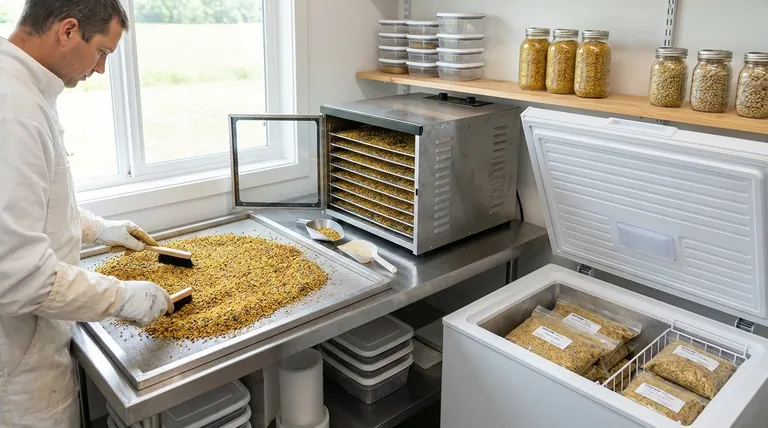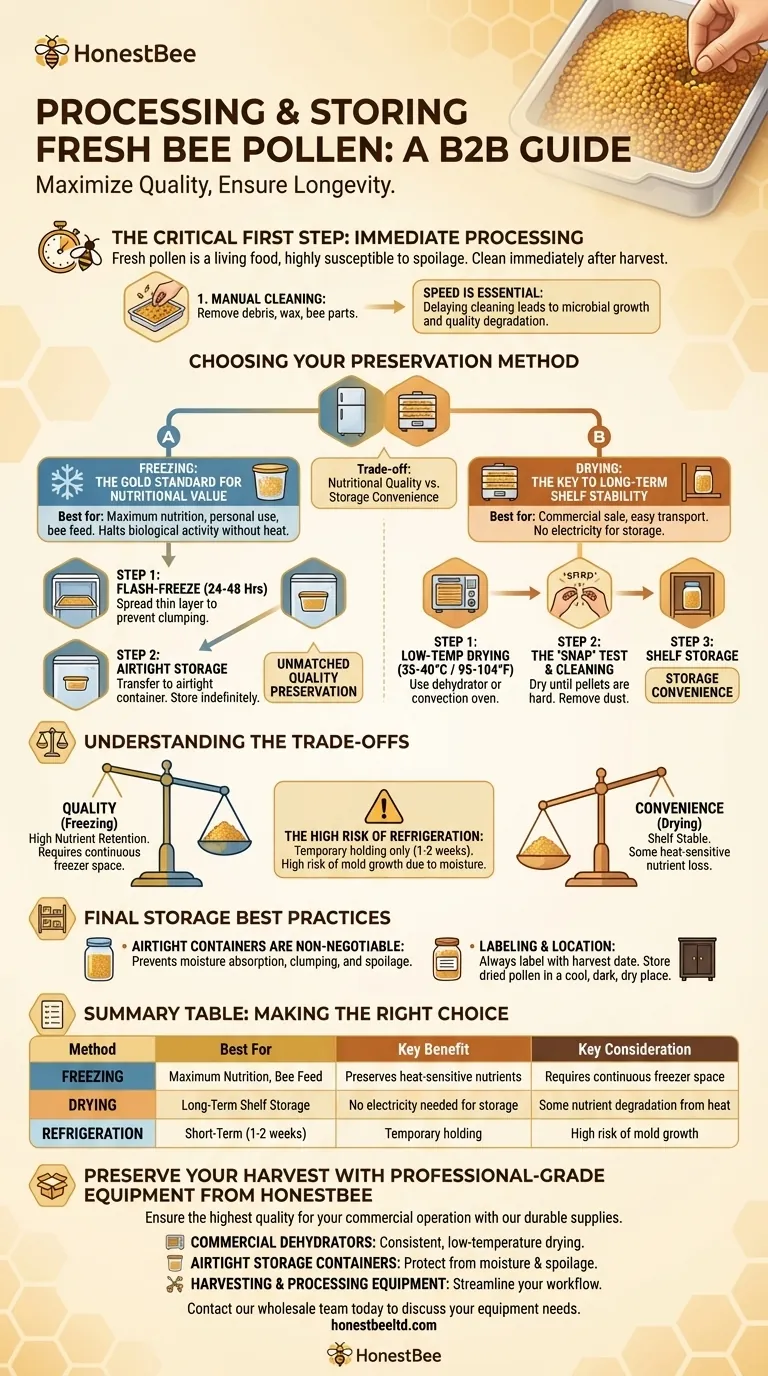To preserve fresh bee pollen effectively, you must clean it immediately after harvest and then choose a preservation method. Freezing is the superior method for maintaining maximum nutritional value and freshness, while careful drying is required for long-term, shelf-stable storage at room temperature.
The core decision in pollen preservation is a trade-off between nutritional quality and storage convenience. Freezing offers the highest quality but requires freezer space, whereas drying provides shelf stability at the cost of some nutrient degradation.

The Critical First Step: Immediate Processing
Fresh bee pollen is a living food, rich in moisture, enzymes, and nutrients. This environment makes it highly susceptible to spoilage, mold, and fermentation within hours of being harvested from the hive.
Why Speed is Essential
The high moisture content of fresh pollen makes it an ideal breeding ground for microbes. Delaying the cleaning and preservation process will rapidly degrade its quality, nutritional profile, and safety.
How to Clean the Pollen
Immediately after collection, spread the pollen on a clean surface to perform an initial cleaning. Manually remove any foreign debris such as bee parts, wax, or bits of vegetation. A more thorough cleaning can be done after the initial preservation step.
Choosing Your Preservation Method: Freezing vs. Drying
Your intended use and storage capacity will determine the best preservation path. Freezing and drying serve two distinct purposes.
Freezing: The Gold Standard for Nutritional Value
Freezing is the preferred method for preserving pollen's full nutritional spectrum. It effectively halts biological activity without using heat, which can destroy sensitive vitamins and enzymes.
This method is ideal for personal consumption or for creating high-quality bee feed, as it keeps the pollen as close to its natural state as possible.
The Freezing Process
First, spread the cleaned pollen in a thin layer on a tray and place it in the freezer for 24 to 48 hours. This flash-freezing prevents the pellets from forming a solid, unusable block.
Once the pellets are frozen solid, transfer them to a clean, airtight container or freezer bag. Frozen bee pollen can be stored indefinitely without significant loss of quality.
Drying: The Key to Long-Term Shelf Stability
Drying is the process of removing moisture to make the pollen shelf-stable for storage at room temperature. This is the common method for commercial pollen that is sold in jars on a shelf.
While effective for long-term storage and easier transport, the application of heat, even at low temperatures, can degrade some of the pollen's nutritional value compared to freezing.
The Drying Process
Use a food dehydrator or a convection oven set to a low temperature, ideally between 35-40°C (95-104°F). High heat will damage the pollen.
Spread the pollen in a thin, even layer and allow it to dry until the pellets are hard and break with a snap. After drying, you can perform a final cleaning by using a fan on a low setting to blow away any remaining dust or fine particles.
Understanding the Trade-offs
Making an informed decision requires acknowledging the limitations of each method. There is no single "perfect" solution for all scenarios.
The High Risk of Refrigeration
Storing fresh, undried pollen in a refrigerator is not a viable long-term strategy. While it may last for a week or two, the cool, moist environment is perfect for mold growth. Refrigeration should only be considered a temporary holding measure for a few days at most.
Freezing: Quality vs. Space
The primary advantage of freezing is unmatched quality preservation. The main disadvantage is the requirement for continuous freezer space, which can be limited and costly.
Drying: Convenience vs. Nutrition
Drying's main benefit is storage convenience. Dried pollen requires no electricity to store and can be kept in a pantry. However, this comes at the cost of a reduction in heat-sensitive nutrients and a change in the pollen's texture and flavor.
Final Storage Best Practices
Proper storage after preservation is the final step to protecting your harvest.
The Importance of Airtight Containers
For both frozen and dried pollen, an airtight container is non-negotiable. It protects the pollen from absorbing moisture from the air, which can cause clumping, spoilage, or mold. It also prevents oxidation and the absorption of other odors.
Labeling and Location
Always label your containers with the harvest date. Store frozen pollen in the freezer. Store dried pollen in a cool, dark, and dry place like a pantry or cupboard to protect it from light and heat, which can further degrade its quality over time.
Making the Right Choice for Your Goal
Your preservation strategy should align directly with your intended use for the pollen.
- If your primary focus is maximum nutritional value and freshness: Freeze the pollen immediately after cleaning.
- If your primary focus is long-term, shelf-stable storage without a freezer: Dry the pollen at a low, controlled temperature.
- If your primary focus is feeding your bees over winter: Freeze the pollen to provide them with the highest quality food source.
By understanding these methods and their trade-offs, you can confidently preserve the quality and value of your bee pollen harvest.
Summary Table:
| Preservation Method | Best For | Key Benefit | Key Consideration |
|---|---|---|---|
| Freezing | Maximum Nutrition, Bee Feed | Preserves heat-sensitive nutrients | Requires continuous freezer space |
| Drying | Long-Term Shelf Storage | No electricity needed for storage | Some nutrient degradation from heat |
| Refrigeration | Short-Term (1-2 weeks) | Temporary holding | High risk of mold growth |
Preserve Your Harvest with Professional-Grade Equipment from HONESTBEE
As a commercial apiary or beekeeping equipment distributor, the quality of your bee pollen directly impacts your product's value and your bees' health. HONESTBEE supplies the durable, wholesale-focused beekeeping supplies and equipment you need to process and store your harvest efficiently at scale.
We provide the tools for success:
- Commercial Dehydrators for consistent, low-temperature drying.
- Airtight Storage Containers to protect your pollen from moisture and spoilage.
- Harvesting & Processing Equipment to streamline your workflow from hive to storage.
Ensure the highest quality for your operation. Contact our wholesale team today to discuss your equipment needs.
Visual Guide

Related Products
- Beehive Handle and Frame Rest Cutting Machine: Your Specialized Hive Machine
- 8-Frame Electric Self-Reversing Honey Extractor Spinner for Commercial Honey Extraction Equipment
- Full Set Beekeeping Electronic Bee Venom Collector Machine Device for Bee Venom Collecting
- Professional Thermostatic Conical Honey Melter
- High Quality Honey Dehumidifier Dryer Thickening Machine for Beekeeping
People Also Ask
- Why is proper beekeeping equipment important? Essential for Safety and Hive Health
- What types of products are available for beekeeping needs? Essential Equipment for Apiaries & Distributors
- What parts of bee equipment should be painted? A Guide to Protecting Your Hive and Your Bees
- How do honey bees develop from egg to adult? The Complete 4-Stage Metamorphosis Guide
- What is an automatic sidebar forming machine? Automate High-Volume Beehive Frame Production



















